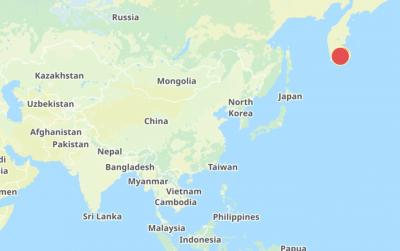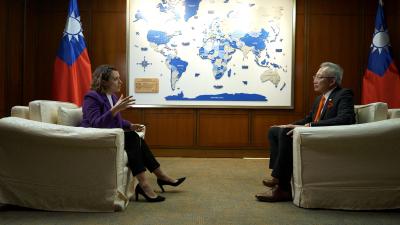An upcoming special exhibition at the National Palace Museum Southern Branch is to feature 13 antique pottery pieces from the Northern Song Dynasty known as ru ware (汝窯), which it said experts consider the “rarest of rarities.”
While 300 pottery items are to be on display, the ru ware created for the imperial court would be the most eye-catching, said Weng Yu-wen (翁宇雯), an assistant researcher at the museum’s southern branch and the planner of the exhibition.
Only 21 objects in the museum’s pottery collection of 25,000 items are ru ware, which are usually displayed individually as the centerpiece of an exhibit, she said on Sunday, adding that the museum has not arranged so many for simultaneous public viewing since the “Grand View” exhibit in 2006.

Photo courtesy of the National Palace Museum Southern Branch
Previously part of the collection of the Qing Dynasty’s Qianlong emperor, the museum’s ru-ware pieces are marked by unusual size and fine crazing, which resembles an insect’s wings, Weng said, adding that the items to be exhibited are “priceless.”
In 2017, a ru-ware brush-washer dish belonging to United Microelectronics Corp founder Robert Tsao (曹興誠), which is of quality inferior to that of any piece owned by the museum, was auctioned at Sotheby’s Hong Kong for HK$294.3 million (US$37.6 million at the current exchange rate), she said.
About half of the exhibit’s other artifacts would be comprised of other Chinese imperial workshop products from the Song, Ming and Qing dynasties, while the other half would be porcelain from Southeast and Northeast Asia, Weng said.
The exhibit was originally conceived with a pan-Asian focus, she said, but added that the plans were expanded after National Palace Museum Director Wu Mi-cha (吳密察) said that the museum should do more to serve the needs of the nation’s central and southern regions.
The exhibition is to run from Saturday next week to Nov. 1, with the entrance fee waived on weekends and holidays until Aug. 31, the museum said, adding that closing time would be extended to 6pm during the period.

The Central Weather Administration (CWA) today issued a "tsunami watch" alert after a magnitude 8.7 earthquake struck off the Kamchatka Peninsula in northeastern Russia earlier in the morning. The quake struck off the east coast of the Kamchatka Peninsula at 7:25am (Taiwan time) at a depth of about 19km, the CWA said, citing figures from the Pacific Tsunami Warning Center. The CWA's Seismological Center said preliminary assessments indicate that a tsunami could reach Taiwan's coastal areas by 1:18pm today. The CWA urged residents along the coast to stay alert and take necessary precautions as waves as high as 1m could hit the southeastern

The National Museum of Taiwan Literature is next month to hold an exhibition in Osaka, Japan, showcasing the rich and unique history of Taiwanese folklore and literature. The exhibition, which is to run from Aug. 10 to Aug. 20 at the city’s Central Public Hall, is part of the “We Taiwan” at Expo 2025 series, highlighting Taiwan’s cultural ties with the international community, National Museum of Taiwan Literature director Chen Ying-fang (陳瑩芳) said. Folklore and literature, among Taiwan’s richest cultural heritages, naturally deserve a central place in the global dialogue, Chen said. Taiwan’s folklore would be immediately apparent at the entrance of the

Speeding and badly maintained roads were the main causes of a school bus accident on a rainy day in Taipei last year that severely injured two people and left 22 with minor injuries, the Taiwan Transportation and Safety Board said. On March 11 last year, a Kang Chiao International School bus overturned inside the Wenshan Tunnel (文山隧道) on the northbound lane of the Xinyi Expressway. The tour bus, owned by Long Lai Co, exceeded the speed limit after entering the tunnel, the board’s investigation found. Sensing that the rear of the vehicle was swaying, the driver attempted to use the service and exhaust

“China is preparing to invade Taiwan,” Deputy Minister of Foreign Affairs Francois Wu (吳志中) said in an exclusive interview with British media channel Sky News for a special report titled, “Is Taiwan ready for a Chinese invasion?” the Ministry of Foreign Affairs said today in a statement. The 25-minute-long special report by Helen Ann-Smith released yesterday saw Sky News travel to Penghu, Taoyuan and Taipei to discuss the possibility of a Chinese invasion and how Taiwan is preparing for an attack. The film observed emergency response drills, interviewed baseball fans at the Taipei Dome on their views of US President